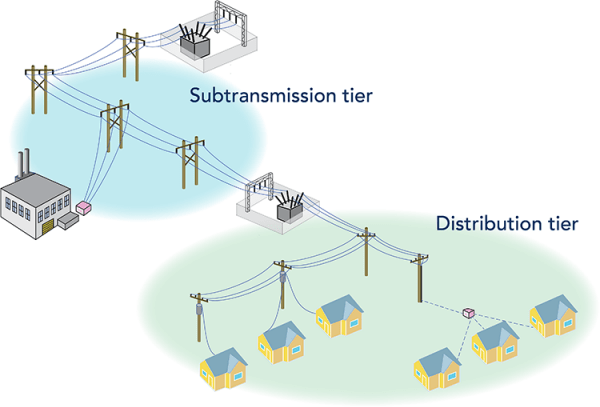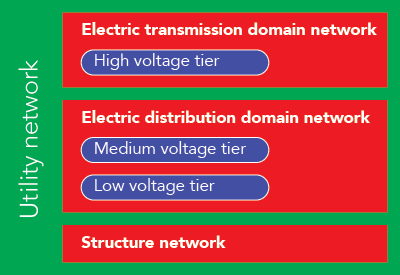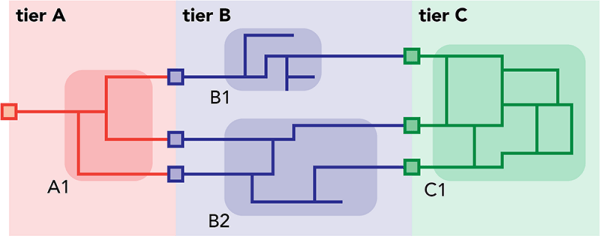You can use tiers to organize a natural hierarchy in a domain network. Tiers typically represent ranges of pressure, voltage, or other characteristic of the network.

Network organization
Utility systems are organized into networks for the delivery of a utility resource.
An electric utility is typically organized into tiers such as transmission (high voltages), distribution (medium voltages), and secondary (low voltages). An electric feature can only be in one tier or another. This is modeled using a partitioned tier definition.
Gas and water utilities have tiers for the gathering of gas or water, transmission of gas or water over long distances, and distribution of gas or water to the consumer. Tier groups are used in the domain network to model the different sectors for a network. For example, in a gas domain network, a tier group of Distribution includes different tiers for system, pressure, and isolation. A feature such as a device can be in two distinct tiers in a tier group. This is modeled using a hierarchical tier definition.
To learn more about the network organization, see topic links discussed in Architecture.

Tier hierarchies can be modeled in one of two ways: through distinct domain networks or through tiers in a domain network. The graphic above shows a typical organization of the hierarchies in an electric utility that illustrates these two options.
First, the electric transmission level is modeled as a distinct domain network. This is done because electric transmission is handled by a different department at the electric utility from electric distribution. There is usually a regulatory requirement for the separation of operation between the transmission and distribution levels of electric power. Because of this requirement, two distinct domain networks for transmission and distribution is the best solution.
Second, the hierarchy within the electric distribution domain network is achieved with two tiers as shown above. The medium voltage tier starts at the low-side terminal of the outbound circuit breaker of the substation. Each circuit within a tier then traverses all the lines and devices until the high-side terminal of distribution transformers, which convert electric power to low voltages. The low voltage tier begins either at the low side of a distribution transformer or at the low side of a network protector in the case of a spot or grid electrical network. This is the best solution for modeling network hierarchy in a domain network that is managed by one department or division.
Tiers
A domain network can have one or several tiers. For example, the electric transmission domain network shown above has only one tier, the high voltage tier.
A tier is a subgrouping of a domain network that represents the logical hierarchy of subnetworks. When you define a tier, you do so by specifying subnetwork control devices, which delimit the subnetworks to that tier. In the above example, a medium voltage tier in an electric distribution domain network would have a subnetwork source feature type of circuit breaker. A low voltage tier would have subnetwork source feature types of distribution transformer or network protectors. These subnetwork control devices are used to define subnetworks in each tier level.
Each tier has a rank number in the hierarchy of tiers. Rank 1 is the high level. In the example above, the medium voltage tier has rank 1 and the low voltage tier has rank 2. Sometimes, different tiers may share the same rank. For example, a gas domain network may have pressure tiers and valve isolation tiers with the same rank because isolation subnetworks can be nested inside pressure subnetworks. See Tier rank for more details.
Tier topology modeling
Tiers in a domain network can have either a hierarchal tier definition or a partitioned tier definition.
Tiers in an electric utility typically follow a partitioned tier definition. This means that there is a progression of tiers (based on declining voltage levels) that are exclusive to each other. A medium voltage subnetwork is distinct from a low voltage subnetwork and does not share features.
Tiers in a gas utility can have a hierarchical tier definition. This means that features in a domain network can belong to subnetworks in two different tiers. For example, a gas utility typically defines a pressure tier and valve isolation tiers with nested subnetworks. A single pressure subnetwork can have several valve isolation subnetworks.
Each tier also has a topology type. This is set at the tier level and pertains to all subnetworks within a tier. Radial is the typical configuration of a medium voltage electric tier. Some gas and water tiers also have radial topology. Mesh is a common topology type of gas and water subnetworks. This is also a topology type of spot or mesh networks in low voltage electric tiers. Dense urban centers have a mesh network with redundant sources for high reliability.
For specific details, see the Topology types section of Subnetworks.

Both topology types are shown in the illustration above. Tier A has a radial topology type. There is one source (at the far left) for the subnetwork labeled A1. Tier B has three sources at the left and has a topology type of radial. Subnetwork B1 has one source and has a radial topology. Subnetwork B2 has two sources and no loops, hence a radial topology. Tier C has a mesh topology. The subnetwork labeled C1 has three sources and several loops. This tier has mesh topology.